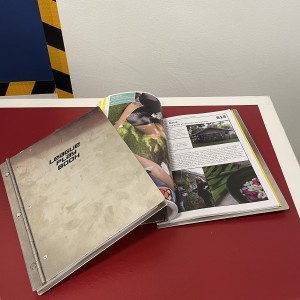League Play Book serves both as documentation of Germaine Koh’s ongoing League project focused on play as a creative practice, and as a kind of workbook that could inspire more invention.
The book is released in free digital edition and a limited-edition bookwork. It is sized for a standard North American three-hole binder, and the bookwork with custom binding is in an edition of 200. Read and download the free PDF at https://germainekoh.com/league-play-book-2025.pdf.
The book is arranged into three sections: Analysis, Plays, and Practice.
The short essays of the Analysis section are written by artists, athletes, scholars, game designers and players who have intimate, lived understanding of the processes of invention and discovery that can develop through play. They share their experiences of the anatomy and dynamics of ingenuity; the culturally radical potential of play; creative mindsets; psychological and cognitive processing; and the situations and settings for discovery. Some analyze the mechanics of how invention and decision-making happen in their fields. Others address how play works to create possibility by revising conventions.
Jesse Birch writes on learning through mimicry in skateboarding, Koh proposes vulnerability and uncertainty as key elements. League collaborator Bruce Emmett shares his recollections of how innovation unfolded at League events in conversation with objects and places. Considering the production of artworks, James Long looks at virtuosic plays of implicit meaning, while Eliot White-Hill narrates his development of work in relation to the traditional forms of his Coast Salish heritage. Revising social conventions, Simona Dolinská describes the potential of neurodivergent play and Elizabeth Nijdam considers critical play. Focusing closely on decision-making, Ian Verchère analyzes the mechanics of progression in games and action sports, Lindsey Freeman writes on the mind games of distance running, and Meaghan Hackinen traces some decision-making in emergent sport.
The Plays section collects case studies written by participants, which outline the creative processes that produced some of League’s events and products. These are not recipes, but they do try to identify the key ingredients, conditions and prompts that encouraged creative decisions.
The Practice section includes worksheets, rooms for notes, and space for users to record their own plays.

